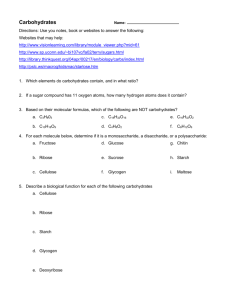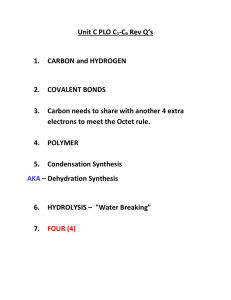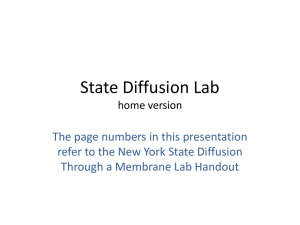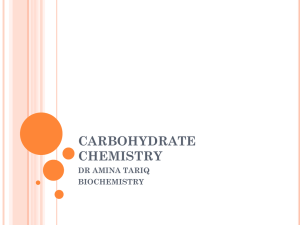carbohydrates_consol..
advertisement
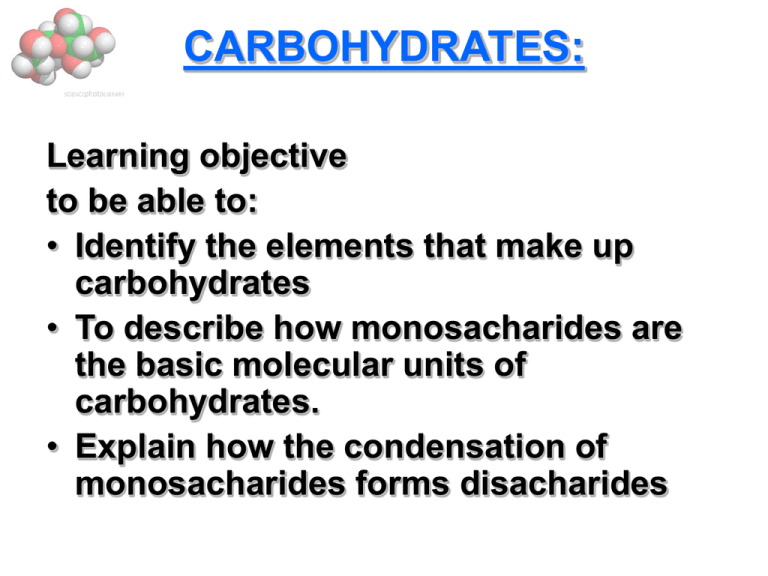
CARBOHYDRATES: Learning objective to be able to: • Identify the elements that make up carbohydrates • To describe how monosacharides are the basic molecular units of carbohydrates. • Explain how the condensation of monosacharides forms disacharides Fill in the table. Place a tick in the box if the statement is correct, place a x in the box if it is incorrect. Statement Starch Cellulose Glycogen Storage molecule in plants x x Polymer of beta glucose Strengthened by thousands of hydrogen bonds x x x x A mixture of two polysaccharides x x x x x Only found in fungi Homework 1) Which three elements are found in carbohydrates? Carbon, hydrogen and oxygen 2) Give two examples of how carbohydrates are used in the body. Immediate energy, storage molecule 3) What is a polymer? Large organic molecule formed by combining many smaller molecules (monomers) in a regular pattern. 4) What is the general formula of a monosaccharide? (CH2O)n 5) What would be the formula of a pentose sugar where n is 5? C5H10O5 6) Fill in the gaps Sugars, starches and cellulose are all examples of monosaccarides are white and crystalline and carbohydrates._______________ sweet tasting solids which __________ dissolve in water. They can be classified according to the number of ________ carbon atoms present in the molecule. Sucrose and Maltose are formed when two monosaccharides join together in a condensation ____________ reaction. The bond that is formed is called a ___________ glycosidic bond. Sucrose is formed when a molecule of glucose _________ bonds with a molecule of _________. fructose Maltose is formed from two molecules of glucose _________. Disaccharides can be broken down into monosaccharides by a ____________ hydrolysis reaction. 7) Distinguish between: a) α glucose and β glucose α glucose found in starch and glycogen, β glucose found in starch, also orientation of OH group on Carbon 1 b) Cellulose and glycogen Cellulose found only in plants, made of sheets of β glucose, glycogen made by animals as their storage polysaccharide, poly (1-4) α α glucose with 9% (1-6) branches c) Amylose and amylopectin. •Amylose is a straight chain poly-(1-4) glucose which coils up into a helix. Amylopectin is poly(1-4) glucose with about 4% (1-6) branches 1. What is the molecular formula of a triose monosaccaride? • C3H6O3 CH2OH 2. Draw the structural H C O OH formula of β-glucose H 3. What would be produced C C by the hydrolysis of sucrose? OH H • Fructose and glucose C C H • List three properties common OH H OH 4. to all monosaccarides and disaccharides – Sweet tasting, soluble, crystalline, white 5. Name 2 structural features of starch that make it a good energy storage molecule – Insoluble – Compact 6. Name a polysaccharide made from β-glucose • Cellulose A key which is used to identify five different types of carbohydrate is shown below: carbohydrate insoluble Contains 1-6 glycosidic bonds Found in animals A glycogen soluble Does not contain 1-6 glycosidic bonds Contains hydrogen bonds B cellulose Transport carbohydrate in plants Does not contain hydrogen bonds D sucrose C amylose Work out the molecular formula for maltose C6H12O6 + C6H12O6 – H2O C12H22O11 Component of DNA E deoxyribose Card sort CH2 OH O HOH2C CH2OH O Fructose OH Galactose OH OH CH2 OH CH2 OH O O OH α glucose OH β glucose OH OH Biochemical tests • All monosaccharides and some disaccharides including maltose and lactose are reducing sugars. • These can be tested for, by adding Benedict's reagent to the sugar and heating in a water bath. • If a reducing sugar is present, the solution turns green, then yellow and finally produces a brick red precipitate. • Non-reducing sugars can also be tested for using Benedict's reagent but first require addition of an acid and heating to hydrolyse (break apart) the sugar. • The acid must then be neutralised using an alkali like sodium hydroxide before carrying out the test as described above. Starch and cellulose • Starch and cellulose are polysaccharides made from the monosaccharide glucose by a series of condensation reactions. • In this activity, you will investigate the formation of these polysaccharides. represents CH2OH H α C H H glucose C OH HO O OH C OH H C C H OH OH CH2OH H C OH β HO O OH H glucose C represents OH C OH H C C H OH H Starch • On the sheet of α-glucose structures, label the carbon atoms and number them. • Cut out each α-glucose unit and, on the top of a plain sheet of paper, place four together in an amylose configuration (use the paper in landscape mode). This involves only 1,4-glycosidic bonds. • Circle the parts of the molecules where the condensation reaction will occur. • Place some more α-glucose units on the lower part of the paper in a chain and then add a 1,6-glycosidic bond to make a branch to the structure. This is amylopectin. Once again, show where the condensation reactions take place. Cellulose • On the sheet of β-glucose structures, label the carbon atoms and number them. • Cut out each β-glucose unit and place six of them on to a piece of paper in a chain. The chain must end up in a straight line and you will need to think creatively how to do this. • Discuss your ideas and ask if you have the correct solution before finally sticking the pieces in place. • As for starch, circle where the condensation reactions occur. • Make a second chain parallel to the first. Where OH and H groups are close together they are attracted and hydrogen bonds form. Draw these bonds in with a pencil.
